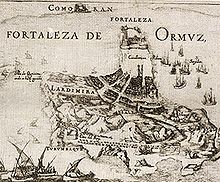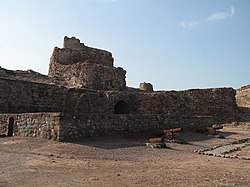Anglo-Persian capture of Hormuz
| Capture of Hormuz | |||||||||
|---|---|---|---|---|---|---|---|---|---|
| Part of Imam Quli Khan and his army (Latin inscription round the fortress). From a Jarūnnāmeh by Qadrī. Isfahan style, dated 1697. | |||||||||
| |||||||||
| Belligerents | |||||||||
|
|
| ||||||||
| Commanders and leaders | |||||||||
|
Imam Quli Khan |
| ||||||||
| Strength | |||||||||
|
3,000 5 warships 4 pinnaces | 1,000 | ||||||||
| Casualties and losses | |||||||||
| Light |
Light 1,000 captured | ||||||||
The Capture of Hormuz (
Background
After the
After the accession of
During this period,
There was thus a clear divergence in the Persian Gulf between Portuguese priorities and Spanish priorities for the region: if the interests of the former were directed towards the Indian Ocean and Asia, Hormuz, due to its political and economic value, was fundamental for the maintenance of the State of India, Castilian interests were clearly oriented towards the Mediterranean, and Hormuz was important because it facilitated the approach to Persia.
— Graça Borges
Despite internal tensions between the ministers of the Crown of Castile and the Crown of Portugal, the Junta of Persia was established at the end of 1618 (made up of 2 members, each, of the Council of Castile and the Council of Portugal, in total). to improve understanding between both Spanish kingdoms) to deal with the question of Hormuz, relating to: the defense of the Iberian possessions in the Persian Gulf against many threats (especially the English and Dutch), the expulsion of the English from the area (or at least to abandon their trade agreements with Persia) and how to treat the Shah's diplomatic relations along with his friendly proposals to grant the Spanish a commercial monopoly on Persian silk on the Cape route. Its purpose was conciliatory, although due to multiple misunderstandings and ambiguities (in addition to the fact that it was only consultative, while the final decisions were made by the Council of State), it only accentuated Persian warmongering.[7]
Thus, ambassador
Anglo-Persian alliance

The English component consisted of a force supplied by the
Operations
The English fleet first went to Qeshm, some 24 kilometres (15 mi) away, to bombard a Portuguese position there.[11] The Portuguese present quickly surrendered, and the English casualties were few, but included the famous explorer William Baffin.[11]
The Anglo-Persian fleet then sailed to Hormuz and the Persians disembarked to capture the town.
Although Portugal and Spain were in a dynastic union from 1580 to 1640, England and Portugal were not at war, and the Duke of Buckingham threatened to sue the company for the capture, but renounced his claim when he received the sum of 10,000 pounds, supposedly 10% of the proceedings of the capture of Hormuz.[1] King James I also received the same sum from the company when he complained as such: "Did I deliver you from the complaint of the Spaniards, and do you return me nothing".[1]

The capture of Hormuz gave the opportunity for the company to develop trade with Persia, attempting to trade English cloth and other commodities for silk, which did not become very profitable due to the lack of Persian interest and small quantity of English goods.[1] The English soldier and merchant Robert Shirley also took an interest in developing the Anglo-Persian trade.[1]
-
The Portuguese castle,KishmIsland
-
The Portuguese castle at Hormuz Island
Aftermath
Following the loss of Hormuz, Portuguese forces, led by Rui Freire de Andrade, launched several attempts at military reconquest in 1623, 1624, 1625 and 1627, as well as a diplomatic attempt in 1631, but all failed. On the other hand, the Portuguese moved to
In 1625/1630, following the Battle off Hormuz (1625), the Portuguese signed a truce treaty with the Persians, who allowed the Portuguese to establish a trading post and fortification at Bandar Kong, which is located on the coast of Iran. Then, in 1631, the Portuguese built the Julfar fort (but it would be lost in 1633), a strategic point of great importance on the Musandam peninsula, and which experienced a period of great prosperity during the Portuguese occupation, serving as a large warehouse of regional trade. The main character of the Luso-Persian war, Rui Freire de Andrada, died in September 1633, and was buried in the church of San Agustín (Muscat). After his death, peace treaties were concluded with the Persians and the English in 1635.
It can be concluded that the Portuguese empire in the Persian Gulf would end up stabilizing again, despite the fall of the fortress of Hormuz. Since new fortifications and trading posts were founded, such as those of Soar, Julfar, Doba, Libédia, Mada, Corfação, Caçapo, Congo (Bandar Congo) and Basra.[12][13]
Within the Hispanic Monarchy, the event led to the Council of Portugal radicalizing its warlike stance (influenced by the local governors and advisors of the Kingdom of Portugal) and opposing any attempt to develop an alliance between the Portuguese and English in the
"It is in no way fit for His Majesty's service, for the reputation of his greatness, for the good of that state [of India], nor for his entire monarchy, to admit any nation of Europe to trade in India."
— Letter sent from Lisbon to the Council of Portugal on February 28, 1623
However, after many discussions, and with Castilian pressure (who emphasized the impossibility of obtaining the resources and forces to fight the Protestant companies alone in the State of India), finally the Council of Portugal would come to consider an alliance with the English at the time. the evident logistical weakness being demonstrated, although declaring it as "forced and obligatory".[7]
«They [Lisbon councilors] are very considerate, and this council has always understood it that way, and would never admit the practice of friendship and alliance with any of the nations [of Europe] if it were considered feasible to contrast them all with power and forces of the crown of Portugal alone, which are so limited that even in the times when India flourished and had relations only with the natural kings [Asian governments], the victories and good successes that His Majesty's [Portuguese] vassals "The things they had in those parts were considered miraculous."
— Consultation of the Council of Portugal, Madrid, March 10, 1623
Although such rapprochement with the English was under the Portuguese condition that the economic damages for the loss of Hormuz be compensated (ideally, the English state was expected to send its ships to help recover Hormuz from what was an illegal act of the English Company). of the East Indies), something that, for the majority of ministers of the Spanish Council of State, was not worth requesting, since they saw it as unrealistic, in the words of Don Pedro de Toledo "Asking the King of England for things impossible for him would be of little effect to us", since it would not be possible to force the English to give up the vast commercial benefits they were receiving from the Persians.[7]
No rapprochement with the English was achieved because The
In turn, during the
See also
Notes
- ^ a b c d e f Chaudhuri, K. N. (12 February 1999). "The English East India Company: The Study of an Early Joint-stock Company 1600-1640". Taylor & Francis. Retrieved 12 February 2024 – via Google Books.
- ^ a b c Sykes, p. 279
- ^ Neill, Stephen (12 February 1984). "A History of Christianity in India: The Beginnings to AD 1707". Cambridge University Press. Retrieved 12 February 2024 – via Google Books.
- ^ "Las Fortalezas Ibéricas en la Península Arábiga (1507-1650)". Revista de Estudios en Seguridad Internacional (in Spanish). Retrieved 8 December 2023.
- ^ SPAIN: RELATIONS WITH PERSIA IN THE 16TH AND 17TH CENTURIES, Encyclopaedia Iranica. "Welcome to Encyclopaedia Iranica". iranicaonline.org. Retrieved 8 December 2023.
{{cite web}}: CS1 maint: numeric names: authors list (link) - ^ ISSN 0076-230X.
- ^ hdl:10174/21722.
- ^ a b Sykes, p. 277
- ^ Knight, Charles (12 February 1866). "Biography: Or, Third Division of "The English Encyclopedia"". Bradbury, Evans & Company. Retrieved 12 February 2024 – via Google Books.
- ^ Sykes,pp. 277–278
- ^ a b c Sykes, p. 278
- ^ "Commentarios do grande capitam Ruy Freyre de Andrada: em que se relatam suas proezas do anno de 1619. em q partio deste Reyno por geral do mar de Ormuz, & costa da Persia, & Arabia até sua morte, Em Lisboa, 1647 - Biblioteca Nacional Digital". purl.pt. Retrieved 9 December 2023.
- ^ Comentários do grande capitão Rui Freire de Andrada. Lisboa: Ministério das Colónias; Agência Geral das Colónias, 1940. 374p. mapas.
References
- K. N. Chaudhuri, The English East India Company: The Study of an Early Joint-Stock Company 1600–1640, Taylor & Francis, 1999, ISBN 0-415-19076-2
- Percy Molesworth Sykes, A History of Persia, Read Books, 2006, ISBN 1-4067-2692-3
Further reading
- Tazmini, Ghoncheh (2017). "The Persian–Portuguese Encounter in Hormuz: Orientalism Reconsidered". Iranian Studies. 50 (2): 271–292. S2CID 165149025.


